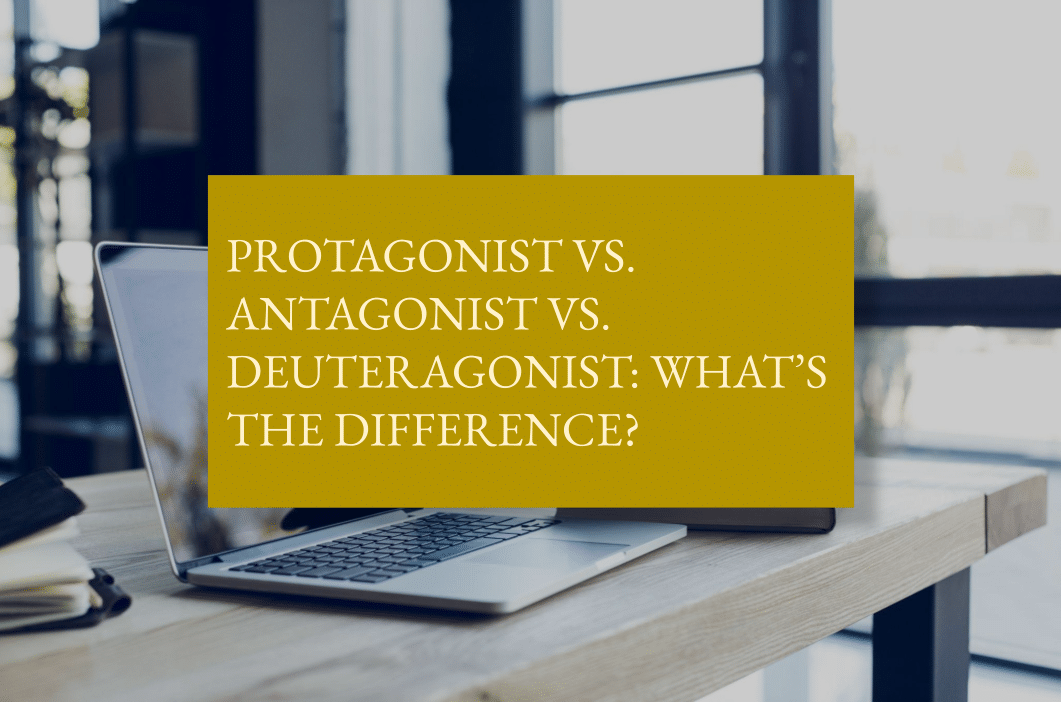
If you’re new to creative writing, or even if you’ve been writing for a little while, you might be feeling overwhelmed by all the literary terminology floating around. It can sometimes feel like you need a diploma in ancient Greek just to know what people are talking about! Don’t worry — that’s why we’re here. We’ll guide you through the differences between these three key players, with some tips for writing your own.
What is the protagonist of a story?
A protagonist is the main character of a narrative. “Protagonist” comes from the Greek word prōtagōnistēs, which means “chief actor” or “chief player”. This means they’re the star of the show.
In a story, the reader will follow the events of the plot through the protagonist’s eyes. Most novels have only one protagonist; however, there are exceptions. Some romance novels will move between two protagonists, and some historical fiction novels will move between two protagonists in two different eras (this is called a “dual timeline”). The Sisterhood of the Travelling Pants and The Kitchen Front both have four protagonists. But this is pretty ambitious and takes a lot of planning!
Tips for writing a strong protagonist
Give your protagonist a dynamic arc
The most successful stories are about inherent change. The protagonist is challenged along their journey, learns from those challenges, and ultimately emerges changed because of them.
If that sounds intimidating, don’t panic; there’s a super sneaky trick to master it easily, and it’s called the value reversal. All you do is choose one negative value — or a positive one, if you’re writing a tragedy — and isolate its inversion. Then, you take your main character from the negative value to the inverted, positive value by the end of the story.
For example, you might choose pride as your negative value. The inverse of this is humility, so your character is going to go from prideful to humble by the end. Or, a greedy, selfish character will learn compassion. The dramatic arc almost writes itself.
Give your protagonist a unique superpower
This doesn’t necessarily mean a literal superpower (although it can be!); it means choosing one thing that your main character is particularly good at. It can be what’s professionally called a “hard skill” — computer hacking, fixing cars, photorealistic drawing — or a “soft skill” — generosity, insightful empathy, street smarts.
If possible, try to make this superpower play a pivotal role in the plot. Just when things seem darkest, the protagonist is able to use this talent or strength to pick themselves back up.
Give your protagonist something to fight for
This directly plays into important narrative concepts like motivation, stakes, and drive. Without something to fight for — and therefore, something to lose — there’s no story.
Broad concepts like peace and justice are noble, but they won’t push a character forward quite as effectively as a more specific, concrete goal: a scholarship that offers freedom from their suffocating small town, the safety of a loved one, the love of the girl next door. The pursuit of this goal will drive their choices and power the plot.
Join our email list for authors
Join our email list for content and opportunities to help you develop your writing, promote your books, and build your author business.
What is the antagonist of a story?
“Antagonist” comes from the Greek word antagonistēs, which means “opponent” or “rival”. They’re someone who comes up against the protagonist and causes conflict. Most novels will have at least a few antagonists: one primary antagonist and a smattering of secondary antagonists.
When we think of the word “antagonist”, we sometimes correlate it with the word “villain”. And while this is sometimes true, an antagonist can also be a good person whose goal is at odds with that of the protagonist. When two people want two different things, and those goals can’t exist at the same time, there’s always going to be conflict.
A good example of this is Pride and Prejudice. Who would you say is the novel’s primary antagonist? Mrs Bennet is a strong contender — not because she’s inherently a villainous person (that honour would go to Wickham), but because what she wants and what the protagonist Elizabeth wants are completely exclusionary. It’s their conflicting wants and needs that sets the story in motion.
In the Harry Potter series, Voldermort is the primary antagonist while Draco Malfoy, Severus Snape, Dolores Umbridge, and others are all secondary antagonists.
Tips for writing a strong antagonist
Give your antagonist sympathetic motives
This isn’t quite the same as empathetic motives, meaning the reader doesn’t have to agree with them — but they should at least understand them. Why does a person do bad things? Are they still bad even if the motivation behind them is good? This is great for raising complex ethical questions, aka your theme.
For example, let’s say your protagonist and antagonist are fighting for the same promotion at work. Your protagonist desperately needs this job to provide for their children, one of which is in need of expensive medical care. But then it turns out your antagonist needs the job so they can afford to leave a dangerous abusive relationship. Who’s right and who’s wrong? Suddenly the story is a lot more interesting and complex.
Give your antagonist a nuanced backstory
If your antagonist is doing objectively unethical and illegal things, what drove them to act this way? What made them the person they are today? No one is born inherently evil — evil is created through the evil person’s experiences.
Consider your antagonist’s upbringing, education, social culture, media influences, and the formative experiences that, directly or indirectly, impacted the choices that they’ve made.
What is the deuteragonist of a story?
“Deuteragonist” comes from deuteragōnistḗs, which means “second actor”. They’re the protagonist’s primary support: a sidekick, best friend, or family member. These characters will often provide comic relief, and may be a stand-in for the reader — the one who goes, are you sure this is a good idea?
It’s not uncommon for deuteragonists to become fan favourites. They become a place where you as the writer can experiment a bit and have fun in ways you might not be able to do with your main character. Ron Weasley, Jane Bennet, and Robin from the Batman comics are all examples of deuteragonists.
Tips for writing a strong deuteragonist
Give your deuteragonist a subplot
As far as your secondary characters are concerned, they are the heroes of this tale. You can really bring your deuteragonist to life by giving them their own journey with their own dramatic arc (that’s the value reversal, remember?).
Thematically, it can be helpful for your protagonist and deuteragonist to be exposed to similar conflicts and ideas, but in different ways.
Make your deuteragonist a character foil
Foil characters are one of the great unsung tricks of the writer’s toolbox. This means juxtaposing two characters in order to highlight their contrasts.
For example, your protagonist might be very shy while your deuteragonist is bold and outgoing. Or your protagonist might be honest to the point of self-detriment, while your deuteragonist isn’t above stealing the answer key to an important test. This approach will make your characters and your story feel fuller and more real.
Fija Callaghan is an author, poet, and unapologetic daydreamer. Her work has been shortlisted and longlisted for a number of short story prizes, and you can find her writing in publications like Gingerbread House, Crow & Cross Keys, Corvid Queen, and Mythic Magazine. When not writing or helping other writers get the best out of their work, she can be found haunting her local bookshops or watching the tide come in.
Join our email list for authors
Join our email list for content and opportunities to help you develop your writing, promote your books, and build your author business.
